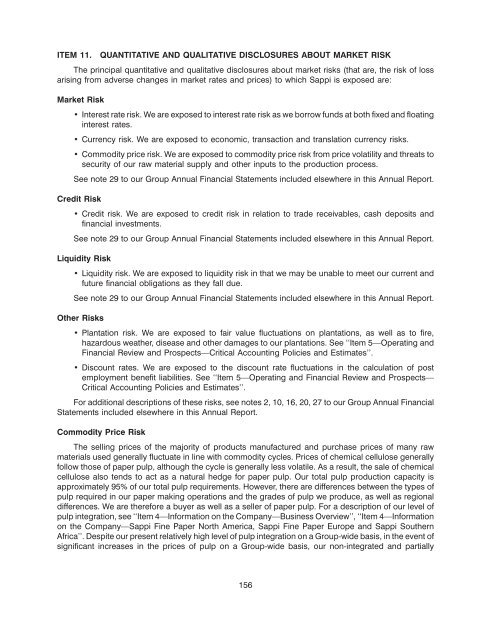Create successful ePaper yourself
Turn your PDF publications into a flip-book with our unique Google optimized e-Paper software.
ITEM 11. QUANTITATIVE AND QUALITATIVE DISCLOSURES ABOUT MARKET RISK<br />
The principal quantitative and qualitative disclosures about market risks (that are, the risk of loss<br />
arising from adverse changes in market rates and prices) to which Sappi is exposed are:<br />
Market Risk<br />
Interest rate risk. We are exposed to interest rate risk as we borrow funds at both fixed and floating<br />
interest rates.<br />
Currency risk. We are exposed to economic, transaction and translation currency risks.<br />
Commodity price risk. We are exposed to commodity price risk from price volatility and threats to<br />
security of our raw material supply and other inputs to the production process.<br />
See note 29 to our Group Annual Financial Statements included elsewhere in this Annual Report.<br />
Credit Risk<br />
Credit risk. We are exposed to credit risk in relation to trade receivables, cash deposits and<br />
financial investments.<br />
See note 29 to our Group Annual Financial Statements included elsewhere in this Annual Report.<br />
Liquidity Risk<br />
Liquidity risk. We are exposed to liquidity risk in that we may be unable to meet our current and<br />
future financial obligations as they fall due.<br />
See note 29 to our Group Annual Financial Statements included elsewhere in this Annual Report.<br />
Other Risks<br />
Plantation risk. We are exposed to fair value fluctuations on plantations, as well as to fire,<br />
hazardous weather, disease and other damages to our plantations. See ‘‘Item 5—Operating and<br />
Financial Review and Prospects—Critical Accounting Policies and Estimates’’.<br />
Discount rates. We are exposed to the discount rate fluctuations in the calculation of post<br />
employment benefit liabilities. See ‘‘Item 5—Operating and Financial Review and Prospects—<br />
Critical Accounting Policies and Estimates’’.<br />
For additional descriptions of these risks, see notes 2, 10, 16, 20, 27 to our Group Annual Financial<br />
Statements included elsewhere in this Annual Report.<br />
Commodity Price Risk<br />
The selling prices of the majority of products manufactured and purchase prices of many raw<br />
materials used generally fluctuate in line with commodity cycles. Prices of chemical cellulose generally<br />
follow those of paper pulp, although the cycle is generally less volatile. As a result, the sale of chemical<br />
cellulose also tends to act as a natural hedge for paper pulp. Our total pulp production capacity is<br />
approximately 95% of our total pulp requirements. However, there are differences between the types of<br />
pulp required in our paper making operations and the grades of pulp we produce, as well as regional<br />
differences. We are therefore a buyer as well as a seller of paper pulp. For a description of our level of<br />
pulp integration, see ‘‘Item 4—Information on the Company—Business Overview’’, ‘‘Item 4—Information<br />
on the Company—Sappi Fine Paper North America, Sappi Fine Paper Europe and Sappi Southern<br />
Africa’’. Despite our present relatively high level of pulp integration on a Group-wide basis, in the event of<br />
significant increases in the prices of pulp on a Group-wide basis, our non-integrated and partially<br />
156
















